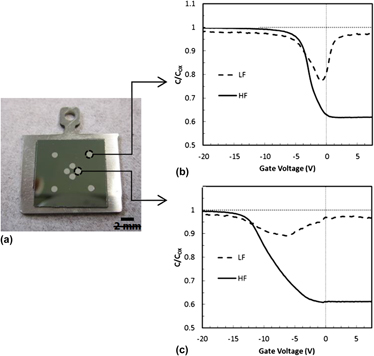Article contents
Tracking subsurface ion radiation damage with metal–oxide–semiconductor device encapsulation
Published online by Cambridge University Press: 05 January 2015
Abstract

We describe measurements aimed at tracking the subsurface energy deposition of ionic radiation by encapsulating an irradiated oxide target within multiple, spatially separated metal–oxide–semiconductor (MOS) capacitors. In particular, we look at incident kinetic energy and potential energy effects in the low keV regime for alkali ions (Na+) and multicharged ions (MCIs) of ArQ+ (Q = 1, 4, 8, and 11) incident on the as-grown layers of SiO2 on Si. With the irradiated oxide encapsulated under Al top contacts, we record an electronic signature of the incident ionic radiation through capacitance–voltage (C–V) measurements. Both kinetic and potential energy depositions give rise to shifted C–V signatures that can be directly related to internal electron–hole pair excitations. The MCI data reveal an apparent power law dependence on charge state, which is at odds with some prior thin foil studies obtained at higher incident energies.
- Type
- Articles
- Information
- Copyright
- Copyright © Materials Research Society 2014
Footnotes
Contributing Editor: Khalid Hattar
References
REFERENCES
- 8
- Cited by




